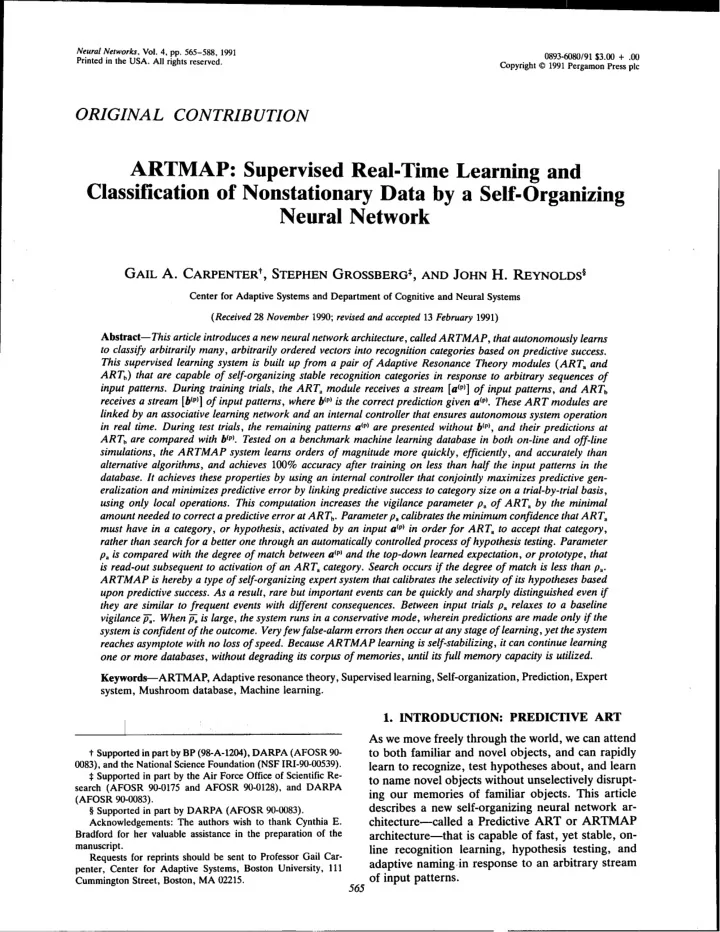

N~urall'!elworks, Vol, 4. pp, 565-588. 1991 0893-6080/91 $3 00 + 00 ' hI "" 1991 . P , P Copyr Prlnled In Ihe USA, All righls reserved, 19 ~ ergamon ress p c I ORIGINAL CONTRIBUTION ARTMAP: Supervised Real-Time Learning and Classification of Nonstationary Data by a Self-Organizing Neural Network GAIL A. CARPENTERt, STEPHEN GROSSBERG*, AND JOHN H. REYNOLDS§ Center for Adaptive Systems and Department of Cognitive and Neural Systems (Received 28 November 1990; revised and accepted 13 February 1991) Abstract- This article introduces a new neural network architecture, called ARTMAP, that autonomously learns to classify arbitrarily many, arbitrarily ordered vectors into recognition categories based on predictive success. This supervised learning system is built up from a pair of Adaptive Resonance Theory modules (ART. and ARTh) that are capable of self-organizing stable recognition categories in response to arbitrary sequences of input patterns. During training trials, the ART, module receives a stream [a(p)] of input patterns, and ARTh receives a stream [b(p)] of input patterns, where b(p) is the correct prediction given a(p). These ART modules are linked by an associative learning network and an internal controller that ensures autonomous system operation in real time, During test trials, the remaining patterns a(p) are presented without b(p), and their predictions at ARTh are compared with b(p). Tested on a benchmark machine learning database in both on-line and off-line simulations, the ARTMAP system learns orders of magnitude more quickly, efficiently, and accurately than alternative algorithms, and achieves 100% accuracy after training on less than half the input patterns in the database. It achieves these properties by using an internal controller that conjointly maximizes predictive gen- eralization and minimizes predictive error by linking predictive success to category size on a trial-by-trial basis, using only local operations. This computation increases the vigilance parameter p. of ART. by the minimal amount needed to correct a predictive error at ARTh' Parameter P. calibrates the minimum confidence that ART. must have in a category, or hypothesis, activated by an input a(p) in order for ART. to accept that category, rather than search for a better one through an automatically controlled process of hypothesis testing, Parameter P. is compared with the degree of match between a(PI and the top-down learned expectation, or prototype, that is read-out subsequent to activation of an ART. category, Search occurs if the degree of match is less than P., ARTMAP is hereby a type of self-organizing expert system that calibrates the selectivity of its hypotheses based upon predictive success. As a result, rare but important events can be quickly and sharply distinguished even if they are similar to frequent events with different consequences, Between input trials P. relaxes to a baseline vigilance p:. When p: is large, the system runs in a conservative mode, wherein predictions are made only if the system is confident of the outcome. Very few false-alarm errors then occur at any stage of learning, yet the system reaches asymptote with no loss of speed. Because ARTMAP learning is self-stabilizing, it can continue learning one or more databases, without degrading its corpus of memories, until its full memory capacity is utilized. Keywords-ARTMAP, Adaptive resonance theory, Supervised learning, Self-organization, Prediction, Expert system, Mushroom database, Machine learning. I 1. INTRODUCTION: PREDICTIVE ART As we move freely through the world, we can attend t Supported in part by BP (98-A-1204), DARPA (AFOSR 90- to both familiar and novel objects, and can rapidly 0083), and the N~tional Science ~oundation (~SF IRI~90-??539), learn to recognize, test hypotheses about, and learn :j: Supported In part by the AIr Force OffIce of ScIentIfIc Re- to name novel objects without unselectively disrupt- Th . b ' t ' 1 search (AFOSR 90-0175 and AFOSR 90-0128), and DARPA. ' f f ' I ' t (AFOSR 90-0083). mg our memones 0 amllar 0 Jec s. IS ar IC e § Supported in part by DARPA (AFOSR 90-0083), describes a new self-organizing neural network ar- Acknowledgements: The authors wish to thank Cynthia E. chitecture-called a Predictive ART or ARTMAP Bradford for her valuable assistance in the preparation of the architecture-that is capable of fast, yet stable, on- manuscript. , C line recognition learning, hypothesis testing, and Requests for reprints should be sent to Professor Gall ar- , ... penter, Center for Adaptive Systems, Boston University, 111 ad~ptlve nammgm response to an arbitrary stream Cumming ton Street Boston MA 02215. of mput patterns. , , 565 -
Recommend
More recommend